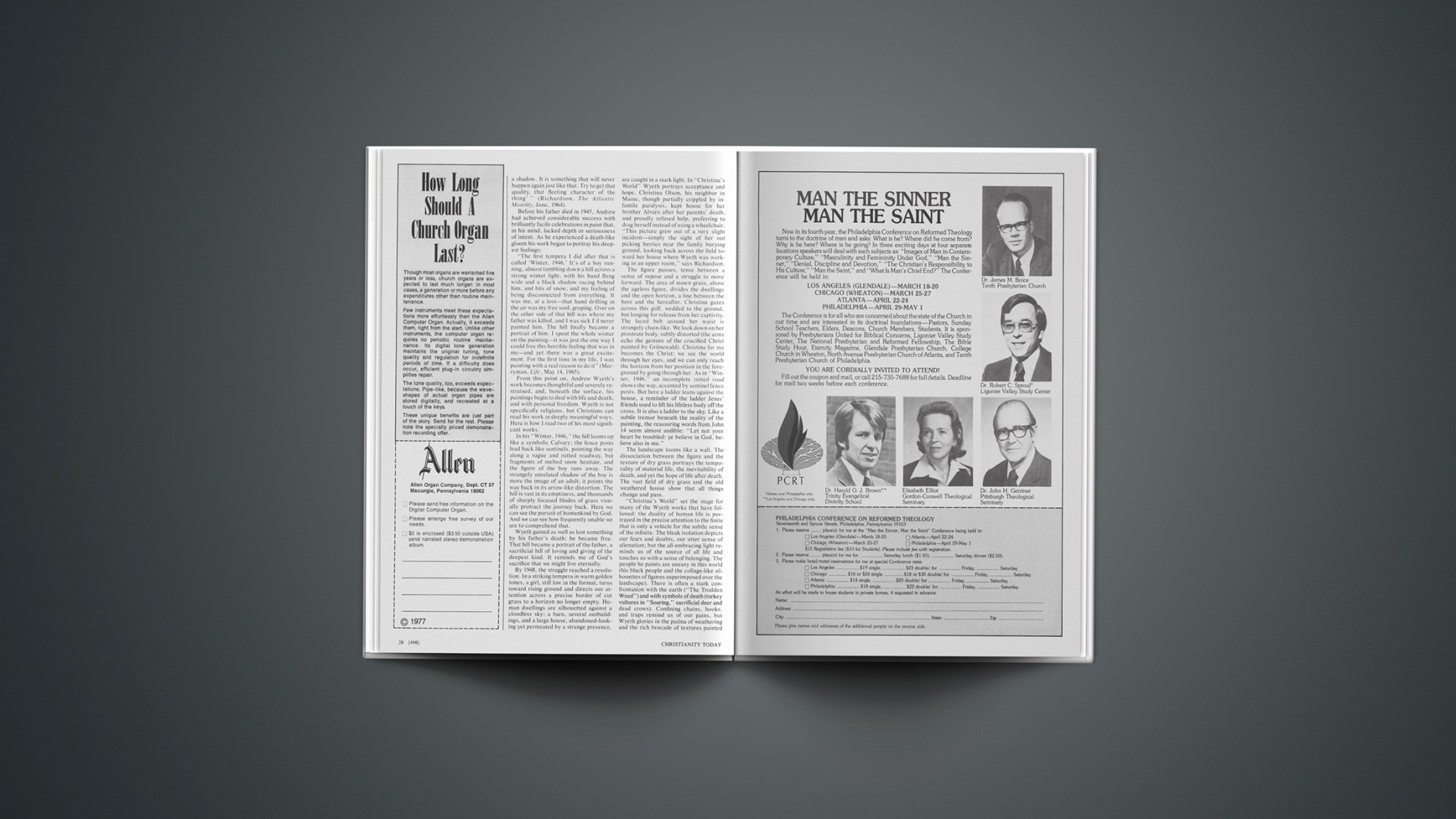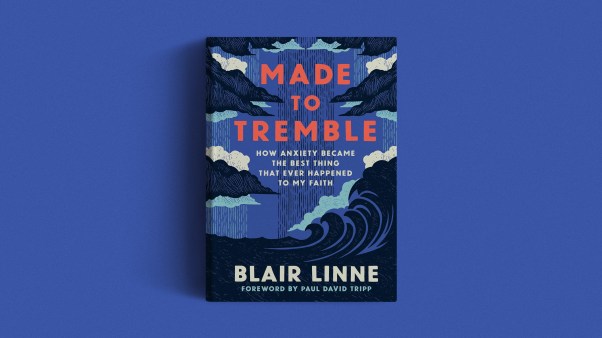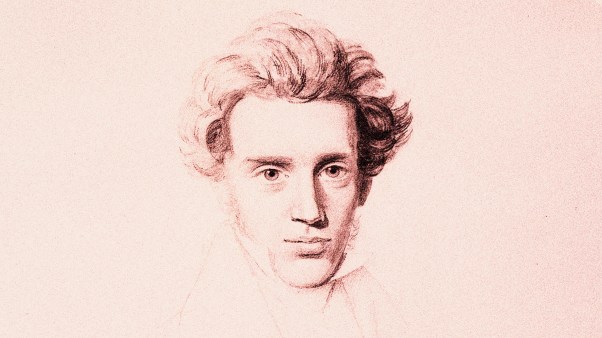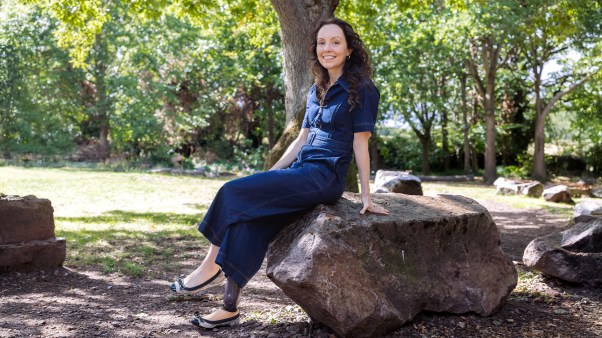“I think one’s art goes as far and as deep as one’s love goes. I see no reason for painting but that. If I have anything to offer, it is my emotional contact with the place where I live and the people I do.”
American artist Andrew Wyeth loves the immediate fabric of life surrounding his private world. The fleeting glimpse of light hitting a weathered pail or fogged window pane or the subtle change in a familiar face can trigger the artist’s intuition to probe deeper and reveal the extraordinary in ordinary things.
The fifty-nine-year-old painter’s world can be divided between the seasons in two places: winter in the hills surrounding Chadds Ford, Pennsylvania, and summers since his boyhood on the seacoast around Cushing, Maine. Wyeth knows this limited domain as he does the palm of his own hand, and more creative images than can be harvested in a lifetime await his eye there. To see beneath the surface, to enlarge those personal observations of the familiar becomes a meditative process of self-discovery. As E. P. Richardson described it years ago in the Atlantic Monthly, “It was becoming clear to me as he talked that the aura of memory which is so strong in Wyeth’s pictures is not an element observed in the subject and painted by him; it is a feeling in the artist himself, intensely felt and powerfully expressed in a mysterious but cogent way through the subject.”
Wyeth found in his own back yard images profoundly stirring and beautiful because of the deep personal meaning they hold for him. Through painting these images, Wyeth often becomes his subject while achieving a detachment, an objectivity that lets us feel his subject for ourselves. In his article for Life, Richard Merryman quotes Wyeth: “I wish I could paint without me existing—that just my hands were there.” In discussing his portrait of Ralph Cline, Wyeth said: “It’s as though, when I painted ‘The Patriot,’ I’d disappeared, was disembodied—floating above it.” And we are transported, in seeing his work, out of ourselves by what Richardson has called “his power to translate simple objects to another plane of feeling.”
To a great extent, Andrew Wyeth’s achievement of selflessness is the result of the medium he has chosen for his major works: the exacting and time-consuming medium of egg tempera must be built stroke by stroke. In this Quattrocentro medium, yolk of egg is mixed with powdered pigments and applied in thin layers to the absorbent bone-white of a gessoed panel. “I really like tempera because it has a cocoon-like feeling of dry lostness—almost a lonely feeling. There’s something incredibly lasting about the material, like an Egyptian mummy, a marvelous beehive or hornet’s nest.”
The time delay between initial lay-in of color washes and the final articulation of specific textures and minute calligraphy of light gives the artist time to dream, time to become lost in the process, and time to drift away and view the work almost as a stranger to it. Building the intricate web of brushstrokes that finally crystallizes his image is an act of possession, a love in his labor.
Because the subject is often the kind of thing most of us leave unnoticed—something too ordinary or even too ugly to love—looking at a Wyeth can be a lesson in seeing the beautiful in all things. But egg tempera has a characteristic no other medium can match, a quiet luster. Its medium is light. And symbolically light plays a central role in Wyeth’s work. The source is unseen but all-pervasive.
Since his boyhood, when he was apprentice-trained by his father, the robust and expansive N. C. Wyeth, Andrew learned to look at things in a way that transcended the ordinary.
“My father taught me remarkable things, not only in the studio but just living with him. He didn’t put fences around me. He gave me the appetite for looking deeper, made me see the depth of an object. He made me paint still life, and would say to me. ‘When you’re doing that form and shadow, remember it is not just a shadow. It is something that will never happen again just like that. Try to get that quality, that fleeting character of the thing’ ” (Richardson, The Atlantic Monthly, June, 1964).
Before his father died in 1945, Andrew had achieved considerable success with brilliantly facile celebrations in paint that, in his mind, lacked depth or seriousness of intent. As he experienced a death-like gloom his work began to portray his deepest feelings:
“The first tempera I did after that is called ‘Winter, 1946.’ It’s of a boy running, almost tumbling down a hill across a strong winter light, with his hand flung wide and a black shadow racing behind him, and bits of snow, and my feeling of being disconnected from everything. It was me, at a loss—that hand drifting in the air was my free soul, groping. Over on the other side of that hill was where my father was killed, and I was sick I’d never painted him. The hill finally became a portrait of him. I spent the whole winter on the painting—it was just the one way I could free this horrible feeling that was in me—and yet there was a great excitement. For the first time in my life, I was painting with a real reason to do it” (Merryman, Life, May 14, 1965).
From this point on, Andrew Wyeth’s work becomes thoughtful and severely restrained, and, beneath the surface, his paintings begin to deal with life and death, and with personal freedom. Wyeth is not specifically religious, but Christians can read his work in deeply meaningful ways. Here is how I read two of his most significant works.
In his “Winter, 1946,” the hill looms up like a symbolic Calvary; the fence posts lead back like sentinels, pointing the way along a vague and rutted roadway, but fragments of melted snow hesitate, and the figure of the boy runs away. The strangely unrelated shadow of the boy is more the image of an adult; it points the way back in its arrow-like distortion. The hill is vast in its emptiness, and thousands of sharply focused blades of grass visually protract the journey back. Here we can see the pursuit of humankind by God. And we can see how frequently unable we are to comprehend that.
Wyeth gained as well as lost something by his father’s death: he became free. That hill became a portrait of the father, a sacrificial hill of loving and giving of the deepest kind. It reminds me of God’s sacrifice that we might live eternally.
By 1948, the struggle reached a resolution. In a striking tempera in warm golden tones, a girl, still low in the format, turns toward rising ground and directs our attention across a precise border of cut grass to a horizon no longer empty. Human dwellings are silhouetted against a cloudless sky: a barn, several outbuildings, and a large house, abandoned-looking yet permeated by a strange presence, are caught in a stark light. In “Christina’s World” Wyeth portrays acceptance and hope. Christina Olson, his neighbor in Maine, though partially crippled by infantile paralysis, kept house for her brother Alvaro after her parents’ death, and proudly refused help, preferring to drag herself instead of using a wheelchair. “This picture grew out of a very slight incident—simply the sight of her out picking berries near the family burying ground, looking back across the field toward her house where Wyeth was working in an upper room,” says Richardson.
The figure pauses, tense between a sense of repose and a struggle to move forward. The area of mown grass, above the ageless figure, divides the dwellings and the open horizon, a line between the here and the hereafter. Christina gazes across this gulf, wedded to the ground, but longing for release from her captivity. The laced belt around her waist is strangely chain-like. We look down on her prostrate body, subtly distorted (the arms echo the gesture of the crucified Christ painted by Grünewald). Christina for me becomes the Christ: we see the world through her eyes, and we can only reach the horizon from her position in the foreground by going through her. As in “Winter, 1946,” an incomplete rutted road shows the way, accented by sentinel fence posts. But here a ladder leans against the house, a reminder of the ladder Jesus’ friends used to lift his lifeless body off the cross. It is also a ladder to the sky. Like a subtle tremor beneath the reality of the painting, the reassuring words from John 14 seem almost audible: “Let not your heart be troubled: ye believe in God, believe also in me.”
The landscape looms like a wall. The dissociation between the figure and the texture of dry grass portrays the temporality of material life, the inevitability of death, and yet the hope of life after death. The vast field of dry grass and the old weathered house show that all things change and pass.
“Christina’s World” set the stage for many of the Wyeth works that have followed: the duality of human life is portrayed in the precise attention to the finite that is only a vehicle for the subtle sense of the infinite. The bleak isolation depicts our fears and doubts, our utter sense of alienation; but the all-embracing light reminds us of the source of all life and touches us with a sense of belonging. The people he paints are uneasy in this world (his black people and the collage-like silhouettes of figures superimposed over the landscape). There is often a stark confrontation with the earth (“The Trodden Weed”) and with symbols of death (turkey vultures in “Soaring,” sacrificial deer and dead crows). Confining chains, hooks, and traps remind us of our pains, but Wyeth glories in the patina of weathering and the rich brocade of textures painted with reverence and conserving love. In fragmented patches of snow, spring breaks through winter and, deep in dark woods, decay and rot fertilize the promise of new life, of resurrection, in innocent white flowers.
Andrew Wyeth paints our earthly existence while reminding us that it is only the beginning. The painting becomes a mirror, reflecting our longing for beauty, our longing for love, the artist an oracle pronouncing God’s love for us.
Bill Bristow is a painter and associate professor of art at Trinity University in San Antonio, Texas.
Modern Magic
Where do parents find new fairy tales when their children are tired of the old ones? Keep an eye out for writers who find the fairy-tale form a good fit, such as Richard Kennedy and John Gardner, both of whom have recently published new stories. As C. S. Lewis showed, Christianity can be taken seriously in fairy tales. (Just don’t expect lessons on doctrine; they aren’t the place to look for systematic theology.) Kennedy’s charming new tale The Blue Stone (Holiday House) is a case in point. The story turns on a guest from heaven.
Jack finds a strange blue stone through which he can hear heaven’s harps and angels’ songs. Bertie his wife—more earthly-minded than her husband—thinks that if it’s magical it might bring them food or money. The stone has some strange properties, particularly when swallowed. Figuring out the blue stone helps Jack and Bertie learn what things are important in life.
A similar theme, again in a medieval fairy-tale style, comes from a well-known Swedish writer, Maria Gripe. In the Time of the Bells (Delacorte), a much longer and more involved tale than The Blue Stone, has a fragile vocabulary and delicate images, if one can judge by this felicitous translation. Jack and Bertie are peasants; Arvid and Helge, royalty. The atmospheres differ also. Stone jogs along while Bells whispers its way. Some people may prefer a heartier style, but Gripe knows how to use this light one. It matches the quiet, introspective nature of her protagonist, Arvid. Both books include lovely illustrations.
But John Gardner’s new book is the best of the latest in fairy tales. Gudgekin the Thistle Girl and Other Tales (Knopf) is clever and entertaining while it shows children how to think logically and behave compassionately. The publisher claims that Gardner is carving a story-telling tradition all his own. Judging from this book, that claim may not be exaggerated.
CHERYL FORBES










